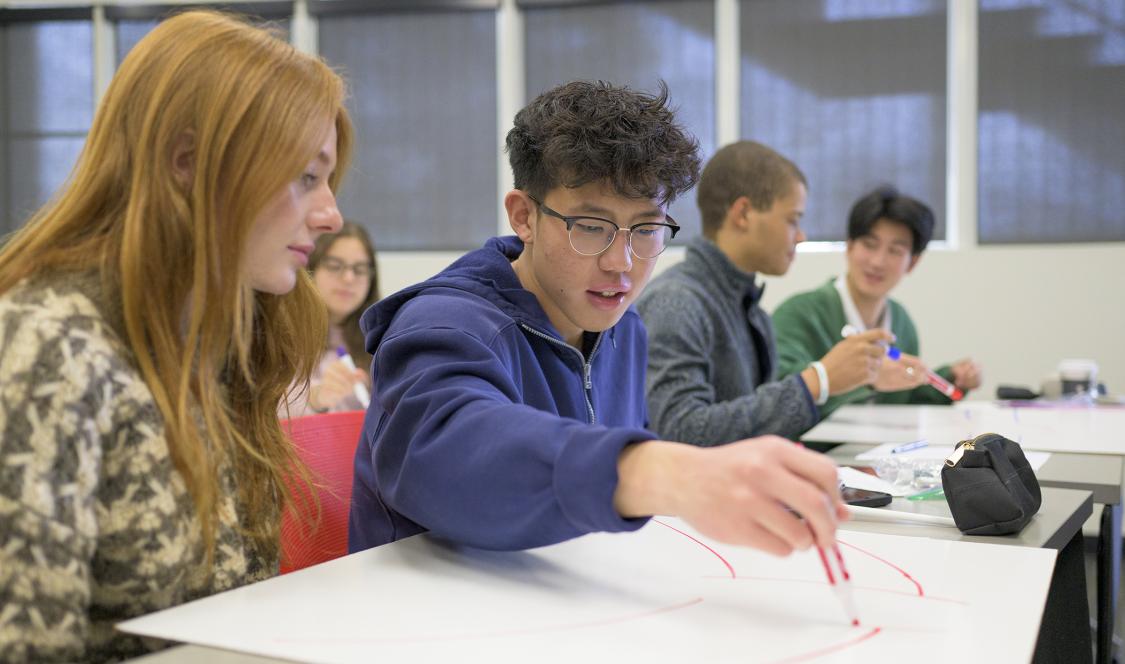Scaling up “Codes of Life”
In an interview, Prof. Ran Libeskind-Hadas, founding chair of the Kravis Department of Integrated Sciences, shared the lessons he’s learned by teaching “Codes of Life,” and offers a preview of future KDIS curriculum.
What are you learning as you teach “Codes of Life”?
We’re learning about what topics interest students, how they engage with the material, and the range of their prior backgrounds. All of that is useful to us as we plan to scale this course up to eventually be taken by every CMC student.
Is your approach to this course similar to what we’ll see in the KDIS curriculum?
The approaches that we’re taking in this course reflect some important aspects of the vision for KDIS. In particular, we’re teaching content just in time to help students explore questions that require multiple disciplinary lenses. For example, we’re teaching them the chemistry that they need just in time to understand the biology of the genome. Similarly, we’re teaching computation just in time so that they write their own programs to analyze genetic data (from soil or water samples that they collected themselves and processed in the lab) and gain insights into questions like, “How prevalent are antibiotic-resistant bacteria in soil samples at the Claremont Colleges?”
What’s next?
Next, we plan to offer this course to more students, ramping up to AY 2024-25 when we plan to welcome all CMC students in this course. At the same time, we’re starting to plan for the next level of courses so that we can offer majors beginning in AY 2024-25. We’re also working on final elements of the design of our new building to support our new curricula and to hiring the faculty!

At first glance, it seems like a typical Claremont McKenna classroom, buzzing with the sounds of collaboration, as students work together in small groups to solve a biochemistry problem posed by Prof. Emily Wiley.
But this is not your typical course. It’s a pilot, the first for the new Kravis Department of Integrated Sciences (KDIS) program, which exemplifies CMC’s key commitments: grounded in solving problems in the public sphere; emphasizing strong connections across disciplines, integrating computing and data science, offering experiential learning opportunities, and fostering a culture of inclusion.

The students are learning foundational principles in the sciences, experimental methods, as well as data science and computer science concepts for scientific insight, including Python programming. And they’re applying what they’re learning to topics that include the prevalence of antibiotic-resistant bacteria in our local water systems, the use of genetic engineering to eliminate certain diseases, and the evolutionary origins of modern humans.
The inaugural spring semester course, “Codes of Life,” is designed as the first building block of future curricular offerings, and requires no prior science or computing experience. The first time on the schedule, the course proved incredibly popular, with enrollment filling up quickly, extending to a waitlist.

“We’ve designed the course content with the goal of being engaging and compelling to all students, whether or not they are science majors,” said CMC Prof. and KDIS Founding Chair Ran Libeskind-Hadas, who co-teaches the course with Wiley and Prof. Zach Dodds, a faculty member in the Computer Science Department at Harvey Mudd College. “There’s a power in having a common language of scientific literacy that every CMC student — no matter their major—understands.”
The trio teamed up to “explore contemporary challenges in human health and the life sciences using a combination of laboratory and computational methods.”

Bryan Soh ’25, who intends to dual-major in international relations and public policy, was drawn to the “Codes of Life” course because of its focus on using “computational methods to solve pertinent scientific issues.” He said it’s one of his favorite classes and especially appreciates how the professors emphasize “the intersections of computational methods and biology while teaching their material” and how they’re applying those methods to the real-world projects they take on in their weekly lab sessions.
“Having some sort of proficiency in data handling is essential, and that’s what I’m hearing from CMC alumni” who are currently in the workforce, he said. “It’s a skill set that can open up a lot of prospects.”
From the instructors’ perspective, “the class is going great!” Libeskind-Hadas enthused. “The students are engaged, they are doing very good work in class, homework, and lab and we see them making progress and asking great questions when they visit us during office hours. The three of us teaching the course together are really enjoying it.”
Together, we can help prepare future leaders with critical technical and scientific fluency — just like Bryan. Make your gift by June 30 to ensure you’re included in the historic Campaign for CMC: Responsible Leadership.
Please visit the campaign site by clicking here.

